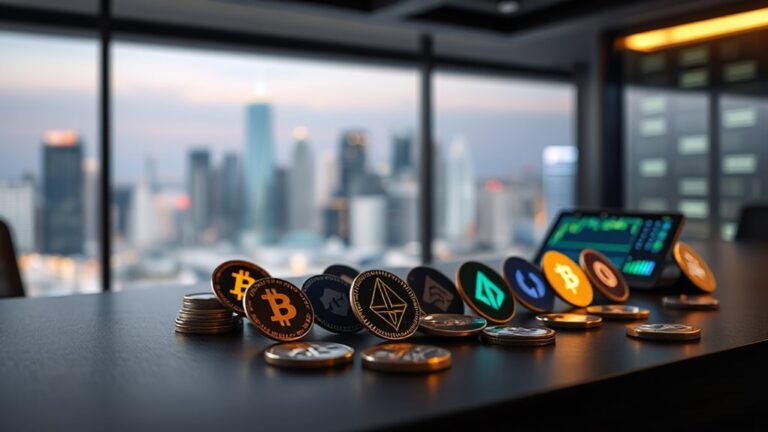
How to Research and Pick Altcoins: A Beginner’s Guide to Investment Success
To successfully research and pick altcoins, one must first understand their different types, such as payment and stablecoins. Evaluating a project's whitepaper and founding team is vital for determining viability. Analyze the project's roadmap for future success indicators. Market dynamics and trends inform strategic portfolio diversification. It is important to recognize investment risks and stay updated on market changes. With this knowledge, investors are better positioned to make informed decisions and potentially uncover more strategies.
Key Takeaways
- Evaluate project whitepapers to understand objectives and technical capabilities, ensuring authenticity and credible references.
- Assess the founding teams' expertise and industry experience to gauge strategic direction and project viability.
- Monitor project roadmaps and track milestone progress to anticipate future success or potential delays.
- Analyze community engagement via social media, participation, and adoption rates for insights on project support and interest.
- Diversify investments across altcoin categories like utility, security, and stablecoins to manage risk and enhance portfolio stability.
Understanding What Altcoins Are

Understanding the fundamentals of altcoins is essential for anyone interested in the cryptocurrency market. Altcoins are digital currencies that offer alternatives to Bitcoin, aiming to tackle its perceived shortcomings. Notable altcoins like Ethereum enable decentralized applications through smart contracts, while Ripple focuses on efficient cross-border transactions.
Litecoin, the first significant altcoin, was created in 2011 and offers quicker transactions than Bitcoin. The market hosts around 16,500 altcoins, each operating on unique blockchain platforms with diverse functionalities. Some altcoins utilize different consensus mechanisms, such as Proof of Stake, which contributes to their typically higher volatility.
Moreover, technological innovations that altcoins bring to the blockchain space enhance the market's diversity and appeal, attracting various stakeholders. Additionally, innovative features like enhanced transaction speeds and community support play pivotal roles in the development and adoption of these digital currencies.
Exploring Different Categories of Altcoins

In the vast world of cryptocurrencies, altcoins can be grouped into various categories, each serving distinct purposes. Payment tokens, like Bitcoin and Litecoin, are primarily used as digital currencies, while stablecoins such as Tether aim to provide stability by linking their value to traditional fiat currencies. Meanwhile, utility tokens offer specific functions within a blockchain ecosystem, and security tokens represent financial securities, often subject to regulatory oversight. Unlike coins that operate on their own blockchains, tokens function on existing platforms, which can have significant implications for how they are utilized in different ecosystems.
Altcoin Category Overview
Although many investors focus primarily on Bitcoin, the world of altcoins offers a diverse range of options that warrant closer examination. Altcoins are cryptocurrencies distinct from Bitcoin, each featuring unique attributes aiming to address specific challenges or enhance existing technologies. Categories such as payment tokens, stablecoins, privacy tokens, governance and platform tokens, and meme coins provide varied functionality and benefits. This multitude offers investors enhanced diversification potential, with each category presenting its own set of advantages and risks. However, it's crucial to be aware of the significant dangers, such as extreme price volatility, that accompany altcoin investments.
| Category | Key Examples |
|---|---|
| Payment Tokens | Litecoin (LTC), Bitcoin Cash (BCH) |
| Stablecoins | Tether (USDT), USD Coin (USDC) |
| Privacy Tokens | Monero (XMR), Zcash (ZEC) |
| Governance Tokens | MakerDAO's MKR |
The choice of category can greatly influence the investment strategy.
Utility vs. Security Tokens
When exploring the landscape of altcoins, an important distinction between utility and security tokens emerges, each with its distinct characteristics that cater to different investor needs.
Utility tokens provide access to specific services within a blockchain ecosystem, deriving their value from demand for these services. They are largely unregulated and as a result pose higher investment risks due to market volatility. Utility tokens offer benefits including community building and fundraising capabilities within their decentralized applications.
In contrast, security tokens represent ownership in tangible assets and must comply with federal securities regulations, offering more stable investment opportunities and legal protections.
- Purpose: Utility tokens offer service access, while security tokens signify asset ownership.
- Regulation: Utility tokens are often unregulated; security tokens follow securities laws.
- Value Source: Utility tokens depend on service demand; security tokens on asset value.
- Investment Nature: Security tokens promise returns; utility tokens are service-oriented.
Understanding Stablecoins Basics
Stablecoins represent a unique category within the cryptocurrency landscape, designed to offer stability in stark contrast to the volatility typically associated with digital currencies. They are categorized into four types: fiat-backed, crypto-backed, commodity-backed, and algorithmic stablecoins, each employing distinct stabilization methods. Fiat-backed ones, like USDT and USDC, are the most popular, offering simplicity and high liquidity by being backed with fiat currency reserves. Crypto-backed stablecoins such as DAI require over-collateralization to combat volatility. Commodity-backed stablecoins derive value from physical assets like gold. Algorithmic stablecoins maintain value through complex algorithms without collateral. Despite offering a stable value option, each type carries intrinsic risks. In the growing field of decentralized finance, stablecoins serve as a bridge between traditional finance and the crypto world, facilitating secure and efficient transactions.
| Type | Example |
|---|---|
| Fiat-Backed | USDC |
| Crypto-Backed | DAI |
| Commodity-Backed | PAXG |
Assessing Project Viability Through Whitepapers

Whitepapers serve as foundational documents for evaluating the viability of altcoin projects, offering detailed insights into their objectives and technical capabilities.
They provide a thorough overview of the project's goals, outlining how the altcoin aims to address specific issues and presenting technical explanations of its blockchain technology. A focus on authenticity, rather than marketing hype, is essential, with references cited to verify information.
Additionally, these documents should cover:
- Blockchain Functionality: Explaining architecture, scalability, and core features like smart contracts.
- Practical Applications: Highlighting use cases in industries such as DeFi or healthcare.
- Tokenomics and Economic Models: Ensuring the token's role and distribution are clearly defined, including elements such as burning mechanisms that can influence supply and sustainability.
- Roadmap and Progression: Outlining milestones and timelines to gauge future success.
Evaluating Founding Teams and Their Experience

Evaluating the founding teams of altcoin projects is a crucial step in determining a project's potential for success. An effective founding team should display a thorough mix of roles, covering areas like development, marketing, and operations, while benefitting from diverse backgrounds in both cryptocurrency and traditional industries. Having industry expertise, particularly in sectors relevant to the altcoin, enhances credibility and strategic direction. Previous successful entrepreneurial ventures or significant experience in related fields strengthen the team's credibility and appeal. Finally, the ability to innovate, adapt to market changes, and maintain effective communication within the crypto ecosystem are also critical attributes. As the market evolves, it's important for altcoin projects to prepare for institutional adoption, which can significantly impact their long-term viability and success. The following table summarizes key components to evaluate:
| Factor | Importance |
|---|---|
| Roles and Skills | Guarantees balanced team capabilities |
| Industry Expertise | Enhances strategic direction |
| Diverse Backgrounds | Provides thorough insights |
| Past Successes | Builds team's credibility |
| Innovation and Vision | Drives project growth and adaptation |
Analyzing a Project's Roadmap and Progress

In evaluating an altcoin's potential, understanding the project's roadmap milestones is essential, as these indicate key goals and their expected completion dates, helping to measure progress. Progress tracking can involve monitoring whether these milestones are achieved on schedule, which requires regular updates from the project team to guarantee transparency. When deviations in the timeline occur, it is important to assess their impact as they can affect investor confidence and the project's ability to adapt to new challenges. Some promising altcoins, such as those focusing on scalability and interoperability, show the potential for significant innovation and growth by 2025.
Roadmap Milestones Assessment
Evaluating roadmap milestones is vital as they offer insight into a project's direction and its ability to achieve significant progress.
Milestones need to:
- Specificity: Clearly defined and achievable, providing concrete targets for the project.
- Relevance: Aligned with the project's vision, guaranteeing they contribute to overall strategic goals.
- Delays and Adaptation: Transparency in handling delays and adaptability to changes enhances credibility.
- Phased Development: Structured phases with specific milestones guarantee systematic advancement.
Integrating fee-sharing opportunities as a feature in a project's roadmap could also enhance its attractiveness, offering users the potential to earn passive income and increasing the project's appeal in the evolving cryptocurrency market.
Progress Tracking Techniques
Successfully tracking the progress of an altcoin project involves using a variety of techniques to analyze both the roadmap and the overall advancement.
First, an investor should identify core objectives within a project's roadmap, understanding its long-term vision alongside feasible proposed features. Short-term goals are important, as is acknowledging potential implementation barriers.
Development activity offers insights; tracking code repository changes, such as GitHub commits, helps assess active progress. Analyzing developer and community participation, as well as overall sentiment, can provide additional context.
Additionally, evaluating governance aspects through governance tokens can offer insights into how community members influence a project's development and decision-making.
Moreover, evaluating partnerships and collaborations reveals project growth and market positioning. Reviewing regulatory compliance, like adherence to AML and KYC policies, is essential.
Finally, examining market and financial indicators presents a clearer picture of ongoing performance.
Timeline Deviations Impact
When evaluating an altcoin's project roadmap, timeline deviations can greatly affect investor perceptions and market confidence. Changes in project timelines often stem from the need for flexibility in project management, adapting to shifting market conditions.
Such delays can be due to project complexity or resource limitations, and when projects fail to meet milestones, it may lead to community distrust. However, successful projects manage to communicate progress and setbacks clearly, allowing transparent adjustments in milestones which might even indicate strategic shifts.
- Flexibility in Project Management: Adjustments show adaptability but may cause concern over complexities or resource constraints.
- Communication Strategy: Transparency in updates enhances credibility; lack thereof fuels speculation.
- Risk Management and Contingency Planning: Solid plans cushion unforeseen challenges.
- Market Sentiment and Trust Issues: Delays without clear communication harm investor trust.
Gauging Community Engagement and Support

A thriving community can serve as the backbone of an altcoin's success, offering both support and credibility to the project.
To evaluate community engagement, several factors come into play. Social media metrics, including follower counts and interaction levels on platforms like Twitter and Instagram, reveal the community's size and activity.
Participation in forums such as Reddit and BitcoinTalk further highlights engagement and support. Event participation, where members attend conferences and meetups, reflects interest and investment.
Community sentiment can be understood by analyzing positive and negative discussions. Influencer endorsements also elevate visibility, garnering attention.
Additionally, adoption rates, community-driven initiatives, and token usage offer insights into impact and involvement. Feedback mechanisms and decentralization levels indicate responsiveness and community influence.
Interpreting Market Dynamics and Trends

Community engagement serves as a vital factor in evaluating altcoin potential, and as altcoins evolve, understanding market dynamics and trends becomes increasingly significant.
Market sentiment, influenced by social media and investor behavior, plays an essential role in driving altcoin prices. Volatility indicators highlight opportunities for strategic trading, while market capitalization factors show that larger coins typically experience reduced volatility.
The influence of major cryptocurrencies like Bitcoin and Ethereum often sets the tone for altcoin trends due to market interconnectivity.
- Volatility Indicators: Utilizing market volatility for strategic positions.
- Social Media Impact: Understanding price changes through social media.
- Technical Analysis Tools: Employing tools like Bollinger Bands for trend analysis.
- Market Integration: Enhancing value through financial system integration.
Building a Diversified Altcoin Portfolio

Creating a diversified altcoin portfolio involves careful risk management strategies, clear altcoin selection criteria, and a long-term investment plan.
Investors should consider allocating their funds across various sectors like smart contracts and DeFi, balancing established, stable large-cap altcoins with innovative smaller-cap projects to mitigate potential risks.
Establishing a long-term plan that includes regular portfolio rebalancing and dollar-cost averaging can help maintain stability and align investments with individual financial goals.
Risk Management Strategies
While investing in altcoins can offer substantial opportunities for profit, risk management is essential to safeguard a diversified portfolio.
Investors can navigate the complexities of the altcoin market by employing various risk management strategies. Key approaches include diversifying across categories like market capitalization, sectors, and technologies to mitigate risks.
To further structure this process, consider the following strategies:
- Stop-Loss Orders: Implement stop-loss orders to automatically sell assets at predetermined prices, reducing potential losses.
- Allocation Limits: Set percentage limits for investing in individual altcoins to minimize exposure.
- Dynamic Rebalancing: Adjust the portfolio regularly to maintain desired asset allocation as markets fluctuate.
- Stablecoin Inclusion: Add stablecoins to the portfolio for liquidity and reduced volatility.
These strategies help maintain stability and potential success in altcoin investments.
Altcoin Selection Criteria
Selecting altcoins for a diversified investment portfolio involves understanding key criteria to make informed decisions. Investors focus on types and categories, including utility and security tokens, which offer unique benefits and risks. Use cases play a crucial role, with technological innovations such as smart contracts and decentralized finance enhancing altcoin value. A strong development team and active community support reflect potential success and stability. Financial considerations, including market capitalization and liquidity, determine accessibility and potential growth. Understanding regulatory and security factors guarantees a well-rounded analysis of each asset.
| Criterion | Description |
|---|---|
| Altcoin Types | Includes utility, security tokens, stablecoins |
| Use Cases | Smart contracts, DeFi, supply chain |
| Development Factors | Team expertise, roadmap progress, community engagement |
| Market Considerations | Market cap, liquidity, historical trends |
This structured approach aids investors in constructing a sound altcoin portfolio.
Long-term Investment Plan
A long-term investment plan in altcoins requires attention to various facets of the cryptocurrency market to build a diversified portfolio. Understanding market dynamics and risk management can help in crafting a resilient strategy.
Market volatility is a key factor; altcoins tend to have more pronounced fluctuations compared to Bitcoin. As a result, diversification is essential. Spreading investments across multiple altcoins can reduce overall portfolio risk, while also tapping into their higher growth potential.
Allocating funds into different categories, such as top altcoins, DeFi tokens, and small-cap coins, further enhances stability.
- Allocate 70% to top altcoins, and 15% to DeFi tokens.
- Include stablecoins to manage volatility.
- Use dollar-cost averaging to minimize the impact of price fluctuations.
- Regularly rebalance the portfolio to align with goals.
Recognizing and Mitigating Investment Risks

Investment in altcoins carries inherent risks that investors must carefully recognize and manage to protect their assets.
Key risks include market manipulation, where large investors can influence prices due to low liquidity, and the lack of regulation, which exposes investors to scams.
Technological risks are also present, as newer blockchain technologies may have vulnerabilities.
To mitigate these risks, investors can diversify their portfolios by holding a mix of altcoins and stable cryptocurrencies, balance asset allocation for volatility management, and diversify into traditional investments.
Understanding volatility is vital, as altcoins can experience rapid price changes.
Conducting due diligence on projects, ensuring regulatory compliance, and maintaining emotional resilience are essential strategies for safeguarding investments in the dynamic altcoin market.
Staying Updated With the Latest Market Trends

To effectively navigate the evolving world of altcoins, staying informed about the latest market trends is essential for investors.
Utilizing diverse tools and data sources aids in making informed decisions. Real-time data platforms like Chainalysis offer insights into cryptocurrency flows and liquidity.
Investors can compare market caps of altcoins using The Coin Perspective to set realistic price targets. Evaluating financial performance through tools like Token Terminal helps understand revenue patterns and profitability.
Monitoring social media sentiment on platforms like LunarCrush provides a sense of market mood.
- Use market analysis tools such as Chainalysis
- Compare market caps with The Coin Perspective
- Evaluate financial metrics using Token Terminal
- Monitor social media sentiment via LunarCrush
Keeping abreast of market trends guarantees that investors make strategic and profitable investments.
Frequently Asked Questions
How Do Altcoins Impact Overall Cryptocurrency Market Volatility?
Altcoins considerably influence cryptocurrency market volatility by amplifying price fluctuations due to their low liquidity, innovative technologies, regulatory uncertainties, and sensitive market sentiment. These factors contribute to sudden price swings, attracting both opportunistic investors and speculative trades.
What Role Do Stablecoins Play in Altcoin Investment Strategies?
Stablecoins, acting as the monetary "Swiss army knife," provide stability, manage risk, enhance liquidity, and enable diversification in altcoin strategies. These digital lifebuoys offer traders flexibility and security amid a sea of volatile cryptocurrencies.
How Can Token Lock-Up Periods Influence Altcoin Prices?
Token lock-up periods can stabilize altcoin prices by reducing circulating supply, discouraging speculative behavior, and fostering long-term growth. They prevent sudden price drops from large sell-offs, enhancing investor confidence and market stability while impacting liquidity.
What Factors Determine Altcoin Liquidity in Trading Platforms?
Altcoin liquidity is influenced by exchange listings, trading volume, and the number of active traders. Market conditions and token utility also play significant roles. Centralized and decentralized exchanges, alongside market makers, impact liquidity through their trading mechanisms.
How Does Historical Price Data Predict Future Altcoin Performance?
Analyzing historical price data, such as altcoin spikes coinciding with a notable 2017 Bitcoin rally, provides insights into potential future trends. Recognizing past volatility and growth cycles helps investors anticipate and strategize for upcoming market shifts.
Conclusion
In summary, traversing the altcoin market is akin to a digital version of sifting for gold during the California Gold Rush. By understanding altcoin categories, analyzing whitepapers, evaluating founding teams, and keeping an eye on roadmaps, investors equip themselves with essential insights. Additionally, interpreting market trends and diversifying investments helps mitigate risks. Staying informed about the latest developments guarantees a well-rounded approach. With careful research, investors can make informed decisions, maximizing potential returns while minimizing pitfalls.












